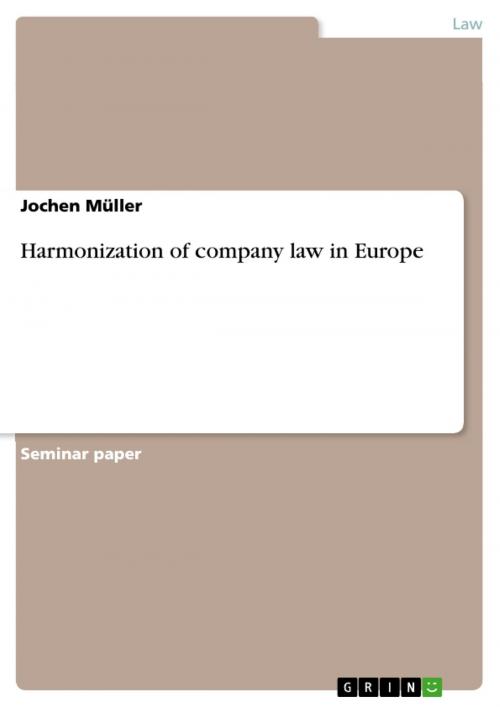| Author: | Jochen Müller | ISBN: | 9783638515344 |
| Publisher: | GRIN Publishing | Publication: | June 30, 2006 |
| Imprint: | GRIN Publishing | Language: | English |
| Author: | Jochen Müller |
| ISBN: | 9783638515344 |
| Publisher: | GRIN Publishing |
| Publication: | June 30, 2006 |
| Imprint: | GRIN Publishing |
| Language: | English |
Seminar paper from the year 2002 in the subject Law - Comparative Legal Systems, Comparative Law, grade: ECTS-Note A (Excellent), University of Bergen (Juristische Fakultät), course: Comparative Company Law, 9 entries in the bibliography, language: English, abstract: European law is a daily reality. The legislation and, correspondingly, the extend of regulations given by the written primary and secondary European Union (EU) law becomes so densely, meanwhile almost as densely as it was hitherto only known from the national regulations system. Consequently, e.g. in Germany, more than 50 per cent of all administrative decisions on federal, state or communal level are taken on basis of regulations coming from Brussels - not everybody is aware of this development yet. From a theoretical point of view, this EU-legislation can be divided into two different types of rules. One type, of course, are the rules passed by the EU-legislator which create new fields of law. This is regularly then the case if supranational European institutions are founded. The by far bigger part of EU-legislation is, however, that type which consists of rules created to harmonize the regulations already existing on national level in the Member States in order to lighten the burden of friction caused by 12 different (not to talk about the future developments, namely the East-Enlargement of the European Union) systems within the EU in the age of globalization, especially seen from an economical point of few. Again, from a theoretical point of view, the legislative instrument of harmonization can be divided into two categories. The first can be described as assimilation and adjustment. It is meant to bring the differing national regulations in one subject of matter, e.g. company law, in a kind of mainstream, i.e. to co-ordinate and to make them similar but not necessarily uniform. The Commission in that case normally uses directives for harmonization of law. The Member States then are obliged to set up their own legislation in a manner that the principle of effectiveness of the EU-rules is not infringed but promoted. Nevertheless, there is room for keeping alive typical and traditional national characteristics of legislation. The second category of harmonization can be described as standardization or, even stronger, unification of law. In that case the means of EU-regulation is used. It takes away the freedom of the Member States to design and set up harmonized rules in their own responsibility. An EU-regulation is binding upon every Member State and it has immediate validity. Thus, unlimited availability of the same law throughout the whole Community is, ideally, being achieved.
Seminar paper from the year 2002 in the subject Law - Comparative Legal Systems, Comparative Law, grade: ECTS-Note A (Excellent), University of Bergen (Juristische Fakultät), course: Comparative Company Law, 9 entries in the bibliography, language: English, abstract: European law is a daily reality. The legislation and, correspondingly, the extend of regulations given by the written primary and secondary European Union (EU) law becomes so densely, meanwhile almost as densely as it was hitherto only known from the national regulations system. Consequently, e.g. in Germany, more than 50 per cent of all administrative decisions on federal, state or communal level are taken on basis of regulations coming from Brussels - not everybody is aware of this development yet. From a theoretical point of view, this EU-legislation can be divided into two different types of rules. One type, of course, are the rules passed by the EU-legislator which create new fields of law. This is regularly then the case if supranational European institutions are founded. The by far bigger part of EU-legislation is, however, that type which consists of rules created to harmonize the regulations already existing on national level in the Member States in order to lighten the burden of friction caused by 12 different (not to talk about the future developments, namely the East-Enlargement of the European Union) systems within the EU in the age of globalization, especially seen from an economical point of few. Again, from a theoretical point of view, the legislative instrument of harmonization can be divided into two categories. The first can be described as assimilation and adjustment. It is meant to bring the differing national regulations in one subject of matter, e.g. company law, in a kind of mainstream, i.e. to co-ordinate and to make them similar but not necessarily uniform. The Commission in that case normally uses directives for harmonization of law. The Member States then are obliged to set up their own legislation in a manner that the principle of effectiveness of the EU-rules is not infringed but promoted. Nevertheless, there is room for keeping alive typical and traditional national characteristics of legislation. The second category of harmonization can be described as standardization or, even stronger, unification of law. In that case the means of EU-regulation is used. It takes away the freedom of the Member States to design and set up harmonized rules in their own responsibility. An EU-regulation is binding upon every Member State and it has immediate validity. Thus, unlimited availability of the same law throughout the whole Community is, ideally, being achieved.















